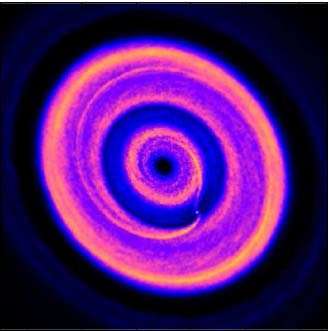The discovery of an exoplanet has most often resulted from the monitoring of a star’s flicker (the transiting method) or its wobble (the radial velocity method). Discovery by direct imaging is rare because it is so difficult to spot a faint exoplanet hidden in the glare of its host star. The advent of the new generation of radio interferometers (as well as improvements in near-infrared imaging), however, has enabled the imaging of protoplanetary discs and, in the disc substructures, the inference of orbiting exoplanets. Gaps and ring-like structures are particularly fascinating clues to the presence or ongoing formation of planets.
Rings of dust have already been identified in many protoplanetary systems from their infrared and submillimeter emission. The origin of these rings is debated. They might have formed from dust “pile-up,” dust settling, gravitational instabilities, or even from variations in the optical properties of the dust. Alternatively, the rings could result dynamically from the orbital motions of planets that have already developed or that are well on their way. Planets will induce waves in the dusty discs which, as they dissipate, can produce gaps or rings. Key to solving the problem is recognizing that different sized dust grains behave differently, with small grains being strongly coupled to the gas and so track the gas mass, whereas larger grains (millimeter-sized or larger) tend to follow pressure gradients and concentrate near gap edges.
CfA astronomers Sean Andrews and David Wilner were members of a team of scientists who used the ALMA facility to image the dust around the young star Elias 24 with a resolution of about 28 au (one astronomical unit being about the average distance of the Earth from the Sun). The astronomers find evidence for gaps and rings and, assuming these are produced by an orbiting planet, they model the system allowing both the planet’s mass and location and the dust’s density distribution to evolve. Their best model explains the observations quite well: after about forty-four thousand years the inferred planet has a mass 70% of Jupiter’s mass and is located 61.7 au from the star. The result reinforces the conclusion that both gaps and rings are prevalent in a wide variety of young circumstellar disks, and signal the presence of orbiting planets.
Provided by:
Harvard-Smithsonian Center for Astrophysics
More information:
G Dipierro et al. Rings and gaps in the disc around Elias 24 revealed by ALMA. Monthly Notices of the Royal Astronomical Society (2018). DOI: 10.1093/mnras/sty181
Find your dream job in the space industry. Check our Space Job Board »
Image:
A model of the dust ring around the young star Elias 24, produced from simulations based on new ALMA millimeter images of the system. The model finds that the dust was shaped by a planet with 70% of Jupiter’s mass located about 60 au from the star
Credit: Dipierro et al. 2018











